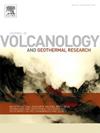The hydrothermal system prior to a phreatic eruption: The case of the 1873 eruption at La Fossa (Vulcano Island, Italy)
IF 2.3
3区 地球科学
Q2 GEOSCIENCES, MULTIDISCIPLINARY
Journal of Volcanology and Geothermal Research
Pub Date : 2025-09-16
DOI:10.1016/j.jvolgeores.2025.108445
引用次数: 0
Abstract
Steam-driven eruptions, such as phreatic and hydrothermal explosions, likely represent some of the most frequent eruptive styles at stratovolcanoes. However, deciphering their timing, dynamics, and underlying mechanisms from eruptive deposits remains a significant challenge, even when, although such deposits are thin, altered, poorly dispersed, and strongly altered, they have not been removed by erosion. Lithic fragments from these eruptions can however preserve valuable information on lithology, pre-eruptive conditions, and the physico-chemical state of the disrupted aquifer. Here we examine the lithic fragments of the “Breccia De Fiore” deposit, emplaced by multiple explosions during a 44-day-long 1873 eruptive phase at La Fossa di Vulcano (Italy). The deposit consists of five poorly sorted lapilli tuff to tuff breccia beds, rich in hydrothermally altered lithics, lacking juvenile material. Petrographic, mineralogical, and geochemical analyses reveal a lithology dominated by silicic and advanced argillic altered particles (44–60 % vol%), together with 23–31 vol% devitrified quartz-bearing fragments hosting vapour-rich fluid inclusions–, and 7–27 vol% unaltered material. These features suggest the disruption of a shallow, acid-sulphate hydrothermal system, a rhyolitic plug occupying the shallow crater-conduit system, and unaltered adjacent lithologies. Quartz textures and fluid inclusions point to vapour-dominated conditions and explosions driven by episodic failure of sealed vapour-pockets within the shallow hydrothermal system, repeatedly recharged by magmatic gas flux. We interpret the 1873 steam-driven eruptions as a series of phreatic explosions occurring in a shallow hydrothermal system under conditions of alteration-driven permeability reduction and magmatic gas and heat input. These results underscore the role of alteration and sustained fluid supply into the hydrothermal system in driving prolonged, non-magmatic explosive activity at Vulcano.

火山喷发前的热液系统:1873年拉福萨火山喷发的例子(意大利火山岛)
蒸汽驱动的喷发,如潜水和热液喷发,可能代表了层状火山最常见的喷发方式。然而,从喷发沉积物中破译它们的时间、动力学和潜在机制仍然是一个重大的挑战,即使这些沉积物很薄、蚀变、分散不佳、蚀变强烈,但它们没有被侵蚀带走。然而,这些火山喷发的岩屑可以保存有关岩性、喷发前条件和破碎含水层物理化学状态的宝贵信息。在这里,我们研究了“角砾岩”矿床的岩石碎片,该矿床是在1873年意大利La Fossa di Vulcano长达44天的喷发阶段中由多次爆炸形成的。矿床由5层差分选的点状凝灰岩—凝灰岩角砾岩组成,富含热液蚀变岩屑,缺乏幼代物质。岩石学、矿物学和地球化学分析显示,岩性主要为硅质和高级泥质蚀变颗粒(44 - 60%体积%),以及23 - 31%体积%含含富气流体包裹体的脱氮石英碎片,以及7 - 27%体积%未蚀变物质。这些特征表明,浅层酸-硫酸盐热液系统被破坏,流纹岩堵塞占据浅层火山口-导管系统,邻近岩性未发生改变。石英结构和流体包裹体表明,浅层热液系统中密封蒸汽袋的间歇性失效驱动了蒸汽主导的条件和爆炸,岩浆气体通量反复补充。我们认为1873年的蒸汽喷发是在蚀变驱动的渗透率降低和岩浆气体和热量输入条件下发生在浅层热液系统中的一系列潜水爆炸。这些结果强调了蚀变和持续的流体进入热液系统在推动火神火山长时间的非岩浆爆炸活动中的作用。
本文章由计算机程序翻译,如有差异,请以英文原文为准。
求助全文
约1分钟内获得全文
求助全文
来源期刊
CiteScore
5.90
自引率
13.80%
发文量
183
审稿时长
19.7 weeks
期刊介绍:
An international research journal with focus on volcanic and geothermal processes and their impact on the environment and society.
Submission of papers covering the following aspects of volcanology and geothermal research are encouraged:
(1) Geological aspects of volcanic systems: volcano stratigraphy, structure and tectonic influence; eruptive history; evolution of volcanic landforms; eruption style and progress; dispersal patterns of lava and ash; analysis of real-time eruption observations.
(2) Geochemical and petrological aspects of volcanic rocks: magma genesis and evolution; crystallization; volatile compositions, solubility, and degassing; volcanic petrography and textural analysis.
(3) Hydrology, geochemistry and measurement of volcanic and hydrothermal fluids: volcanic gas emissions; fumaroles and springs; crater lakes; hydrothermal mineralization.
(4) Geophysical aspects of volcanic systems: physical properties of volcanic rocks and magmas; heat flow studies; volcano seismology, geodesy and remote sensing.
(5) Computational modeling and experimental simulation of magmatic and hydrothermal processes: eruption dynamics; magma transport and storage; plume dynamics and ash dispersal; lava flow dynamics; hydrothermal fluid flow; thermodynamics of aqueous fluids and melts.
(6) Volcano hazard and risk research: hazard zonation methodology, development of forecasting tools; assessment techniques for vulnerability and impact.

 求助内容:
求助内容: 应助结果提醒方式:
应助结果提醒方式:


